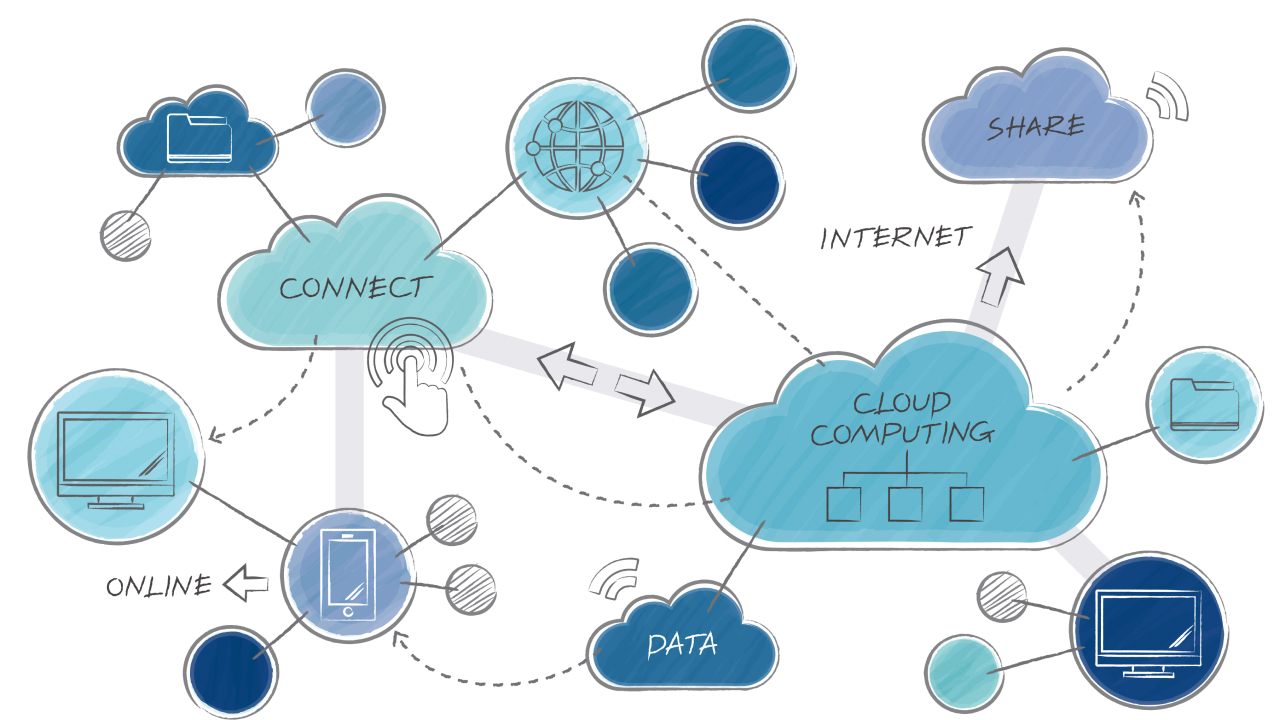The trend for migrating a company’s infrastructure to the cloud intensified in 2020 and hasn’t slowed down since. These days, cloud technologies are gaining more users and bringing some of the highest value among all existing IT tools for business. However, practically every company faces the big challenges of cloud migration.
Migration to the cloud is a way to partially or completely move a company’s digital services, databases, IT resources, and related apps into the virtual cloud space. Thus, the company’s IT infrastructure is transferred under the control of a third-party operator (a cloud provider) governing a dedicated virtual data processing center (DPC).
In this article, our team at EXB Soft will share the benefits of cloud migration and, most importantly, key risks and challenges you might face, based on our experience.
Why Are Companies Increasingly Moving to the Cloud?
Cloud migration is a proven solution for any company looking to boost overall productivity and scale capacities. Instead of maintaining in-house servers and infrastructures, a business can leverage the flexibility and power of cloud platforms. Despite certain potential cloud migration problems, this transition gives businesses a bunch of definitive benefits, like:
- Maximum rational use of internal resources
- Transparent, on-demand payments for consumed cloud resources only
- Minimal costs for maintaining the entire infrastructure by several specialists
- Increased productivity and a slew of new digital opportunities
- 24/7 support and prompt troubleshooting
- Access to cloud resources by employees and company clients from anywhere in the world
- Reduced likelihood of downtime and system failures thanks to cloud providers
- A more competitive business level in technological terms
Some time ago, most companies had to manage exclusively with their own in-house resources. But everybody was quick to adopt cloud-enabled, tailored digital business infrastructures. This method provided the much sought-after flexibility and ability to retain in-house resources.
Today, it is not always possible to ensure the success of a company that runs on its own in-house equipment only. According to our experience, cloud migration is more cost-effective than maintenance and management of outdated on-premise infrastructure - if migration was performed by experts, of course.
Cloud providers’ helping hand
Cloud providers offer specialized services to reduce companies' operating costs and make maintenance of the infrastructure easier. They use advanced data security tools, including encryption, multi-level authentication, and security monitoring. In this way, companies free up their resources for innovation and product development.
A complete transition of all the company’s resources to the cloud is not always the right decision, however. On-premise infrastructure requires the implementation of monitoring tools to prevent data duplication on older systems and reduce the risks related to decommissioned equipment.
Cloud migration issues are tackled through careful analysis, thoughtful planning, and precise execution. You need to make sure that the cloud solutions fit harmoniously with the company's specific business needs. When you develop a migration strategy, take into account not only your business goals but also the optimization of your business operations.
Benefits of Timely Cloud Migration
In the long run, your cloud transformation can reduce IT expenses and enable your organization to quickly respond to changes in the market while preserving chunks of budget. But a cloud-enabled infrastructure also brings the following benefits:
Availability
According to the service-level agreement (SLA), the cloud provider grants users, whether employees or clients, access to company resources from anywhere in the world. The distributed architecture of cloud platforms and data backups prevents the loss of information in the event of operational failures or emergencies.
Cloud services can ensure the continuous operation of apps and services even under unforeseen circumstances. Cloud transformation also allows IT employees to focus more on advancements that improve business goals rather than on mandatory infrastructure maintenance.
Flexibility and scalability
Large volumes of work and changing user needs require a quick adaptation of businesses. Increased flexibility and scalability through the cloud make it easy to change and adjust both strategies and workflows. Cloud solutions feature easy scalability with increasing load and number of users.
In order to scale, companies do not need to buy physical servers, licenses, and extra network equipment. All you need to do is find a reliable cloud provider, discuss all the details, and migrate without making that big of an overhaul or dramatic investment into the cloudification of your infrastructure.
Reduced cost
Using cloud migration tools, you can improve the performance of your apps and websites, as well as reduce network latency through strategically located data centers. Cloud technologies allow companies to quickly access additional resources as needed.
This helps the IT infrastructure to easily adapt to changing requirements, and the business can grow without unnecessary expenses. Switching to a cloud service means quickly achieving tangible results, increasing revenue, reducing costs, and increasing operational efficiency.
Simplified management
The flexible remote environment is great for building in-house and enterprise apps, databases, remote desktops, CRM interaction models, and administration tools. Cloud solutions leverage the efficient use of available resources and simplify the business management process.
On top of that, the migration of your infrastructure to the cloud allows you to delegate a set of responsibilities (mostly technical ones) to the cloud provider. This takes off the strain from setting up, managing, and securing the under-digitized IT infrastructure.
Challenges in Cloud Migration and Their Solutions
The transition to a cloud tech foundation is a timely decision for the digital transformation of any company. Some companies that would benefit from moving to the cloud refuse this solution because of misconceptions about how it works. Experts know that the cloud migration process usually comes with some difficulties. So poorly conducted cloud migration can manifest itself in different ways.
According to McKinsey & Company, moving to the cloud often involves overcoming costly hurdles. Many companies face data security problems, software slowdowns, insufficient skills of company personnel, etc.
But with practical steps to manage cloud migration, you can avoid these and other issues. So, what are the main challenges of migrating to the cloud, and how can these risks be mitigated?
Data security and compliance
Granting the security of the company’s data and compliance with the General Data Protection Regulation (GDPR) must be a top priority. Companies have to take into account cloud migration security challenges and incorporate appropriate measures as early as the planning stage.
Careful configuration and strict adherence to security measures eliminate the vulnerability of the entire system and prevent data leakage. Cloud services use a shared responsibility model in which the provider secures the infrastructure, and the user takes up workload distribution and external resource management.
- Solution:
Companies have to monitor the movement of data from the cloud to their infrastructures and control the workload. You should implement these measures as part of the company's data security strategy. Learn more about EXB Soft services and professional packages
Uncertain cost of the cloud migration process
While migrating to the cloud can improve the return on investment (RoI) in the short and long term, the transformation itself requires an investment of time, money, and resources. Estimating the costs of planning and implementing cloud migration is vital.
Without clearly established costs of migration, assessing the overall economic success becomes a puzzle. The cloud environment evolves and expenses fluctuate with new services added and apps used. This makes cost management one of the major challenges with cloud migration.
- Solution:
The economic basis for moving to the cloud provides an opportunity to assess readiness for this process. Determining the scope of work is necessary to achieve the smooth functioning of cloud workflows and calculate the likely expenses, timing, and impact before the migration begins.
Wrong cloud migration strategy
Initial assessment, proper planning, and strategy definition are the principal steps in a successful cloud migration. A complete and correct understanding of the existing infrastructure and clearly defined migration goals will help you effectively set priorities according to the organization's needs.
Many entrepreneurs choose the simplest transition option, using a “lift-and-shift” approach. Accordingly, all applications intended to be moved to the cloud should be quickly updated. Simply because updating old apps is more cost-effective than creating new ones from scratch.
- Solution:
Make a detailed assessment of your existing infrastructure and create a thorough strategy for moving to the cloud. Consider improvement options for acceptable cloud performance and shape the entire architecture.
No internal capacity for cloud migration (skill gap)
Cloud platforms can be a new challenge for in-house teams accustomed to traditional IT environments. Employees must be armed for the upcoming cloud data migration challenges. The lack of relevant knowledge and skills can result in serious omissions that can jeopardize the safety and reliability of the whole system.
That’s why you have to train existing staff or hire new personnel with the necessary cloud skills. In addition, internal culture often needs to change and merge so that the team members can learn and effectively use new tools and manage cloud migration processes.
- Solution:
To make sure that cloud solutions serve you as planned, you need professionals with extensive experience and knowledge in the field. Long-term mentoring, coaching, and support will allow you to build a perfect team of professionals.
Migration complexity
The overall complexity of cloud migration depends on the company’s architecture and licensing obligations. The migration process may also pose some challenges in terms of planning and costs. Before starting to migrate to the cloud, you have to select a reliable cloud provider by many criteria.
Keep in mind that different providers offer different capabilities, technical solutions, and data center locations. As a client, you need to select the future cloud provider individually, which means that the budget for cloud implementation can fluctuate a lot.
- Solution:
Certain criteria should guide your choice of cloud provider. The better you know what you want from the cloud provider, the easier it will be to make a decent pick.
Low application performance after migration
Before moving to the cloud, you need to identify the technical complexities of existing systems and determine appropriate ways to manage them. For instance, some apps may be interdependent while updating and moving others may cause malfunctions and conflicts with other tools.
The systems that you formerly used may not be cloud-compatible at all. In this case, they may require substantial refactoring or even complete upgrading. Mission-critical apps may also be the most difficult to be moved to the cloud.
- Solution:
A successful migration requires a maximal focus on resolving all technical issues and setting up the infrastructure for the cloud environment. Start with apps that are relatively easy to move and provide quick value once they are in the cloud.
Network bandwidth
Moving apps and data to the cloud imposes new demands on a company's network, impacting two key performance factors: network bandwidth and latency. During or after migration to the cloud, network bandwidth increases dramatically, and abrupt changes in traffic patterns are observed.
The existing requirements of data size for various workloads may exceed network capacity. This can result in delays that slow down business transactions and the system as a whole.
- Solution:
Before migration, test strategic business transactions to visualize and quantify end-to-end network constraints. In this way, you can improve existing performance and identify more areas for growth.
Cloud environment adoption resistance
Successful adoption of cloud technologies is only possible with a deep knowledge of existing infrastructure and an understanding of the real gaps in staff skills. Moving to the cloud involves technological changes and upheavals for employees.
In a company, a team has to change their work processes and adapt to new ways of working. From initiating the transition to managing short- and long-term costs and improving employee skills, the success of cloud migration lies in taking a holistic approach to the process.
- Solution:
Competent staff management and a sound control plan are critical to achieving an effective migration to the cloud.
Azure Linux migration
The growing adoption of Linux on Azure, details why it's a preferred platform for many businesses. It introduces Azure Migrate, a free tool that simplifies the migration of workloads, including Linux VMs, apps, and databases, to Azure. Check video demonstrates how to discover existing systems, assess readiness and costs, and perform migrations efficiently. It also showcases the benefits of Azure's optimization tools and features, such as cost savings, performance improvements, and hybrid benefits, ensuring a smooth transition and enhanced infrastructure management in the cloud.
Migrate to Cloud with EXB Soft Professionals
There is no single right way to migrate to the cloud. The key to successful cloud migration lies in detailed planning, choosing the right methods, and backing of IT experts. Although cloud technology may seem like a real lifeline for contemporary businesses, you need to weigh all the nuances and make an informed and thoughtful decision.
Cloud migration is a major milestone for many businesses. So, selecting the right and reliable partner is a must. EXB Soft provides a full range of services that help solve various technical challenges in cloud migration. Our team handles any and all tasks with a focus on the provision of dedicated development teams with specialization in .NET and JS (Angular, React, and Vue). EXB Soft provides unique and advanced approaches to automation for cloud migration. Based on the company's actual and target level of digital maturity, our experts can tailor the migration program based on the individual processes and technologies.
We understand that cloud migration is not just a matter of technology. Your digital transformation should match your business goals. We can assess, plan, and optimize software to give you a trouble-free transition to the cloud without productivity loss.
Also, we offer an IT audit service to help you understand the readiness of your IT infrastructure for migration. Our team of professionals can help you develop and implement a cloud migration strategy that makes the most sense for your business’s internal goals.
Conclusion
Commonly, companies of all sizes need assistance with challenges, risks, and approaches to migration into the cloud. This business shift must be carried out in several stages with regular testing and verification. However, the longer the process of migrating to the cloud is, the higher the cost of this transition.
The speed and smoothness of your cloud migration process depend on the choice of professionals to help you with this. With the assistance of our experts, your cloud transformation will be much easier and faster. Feel free to contact us for a consultation with seasoned IT experts.
F.A.Q
The main benefits include increased productivity, cost savings, flexibility, scalability, simplified management, 24/7 support, reduced downtime, and access to cloud resources from anywhere in the world. Cloud migration also enables businesses to leverage advanced data security tools and innovative digital opportunities.
Common challenges include data security and compliance, uncertain costs, wrong migration strategy, lack of internal capacity (skill gap), migration complexity, low application performance after migration, network bandwidth issues, and resistance to cloud environment adoption.
Companies should monitor data movement, control workloads, and implement strict security measures from the planning stage. This includes using encryption, multi-level authentication, and security monitoring tools provided by cloud services to prevent data leakage and ensure compliance with regulations like GDPR.
To manage costs, companies should assess readiness, define the scope of work, calculate likely expenses, and establish a clear migration plan. Understanding the economic basis of cloud migration and having a thorough cost assessment before starting can help in achieving a smooth transition.
Companies should provide training for existing staff or hire new personnel with the necessary cloud skills. Long-term mentoring, coaching, and support can help build a competent team. Additionally, collaborating with experienced cloud migration professionals can ensure a successful transition.
Companies should identify technical complexities, start with apps that are easy to move, refactor or upgrade incompatible systems, and focus on resolving technical issues. Testing strategic business transactions to quantify network constraints can also help in improving performance.
Companies should manage staff effectively, provide sound control plans, and ensure employees understand the benefits of cloud migration. Providing training, fostering a culture of adaptation, and clearly communicating the advantages of the new cloud environment can help in overcoming resistance.



